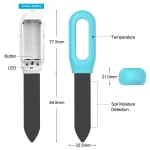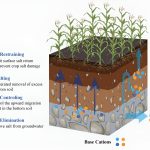Choosing the right seeds for your soil is like finding the perfect partner for a dance. If the match is right, the results can be magical.
As you stand at the crossroads of gardening or farming, the choices can seem overwhelming. But don’t worry; this guide is here to help you make informed decisions that will set you up for success. Imagine lush, thriving plants that turn your garden into a vibrant oasis.
Wouldn’t that be rewarding? Understanding your soil’s unique characteristics is the key to this transformation. In this practical guide, you’ll learn how to select seeds that align perfectly with your soil’s needs, ensuring that your efforts yield the best possible results. Are you ready to unlock the secrets to a flourishing garden? Let’s dive in and discover how you can make your gardening dreams come true.

Importance Of Soil Assessment
Understanding the soil is the first step to successful gardening or farming. Soil assessment is crucial because it directly impacts seed selection and growth. Different seeds thrive in different types of soil, so knowing your soil’s unique characteristics can make or break your planting efforts.
Why Soil Assessment Matters
Think about your garden as a gourmet chef’s kitchen. Just like a chef selects ingredients based on taste and texture, you need to pick seeds that match the soil’s profile. Soil assessment helps you make informed choices, ensuring your plants get the right nutrients.
Imagine planting a tomato seed in sandy soil expecting juicy fruits. Without assessing the soil, you might end up with stunted plants. Soil assessment can save you from such disappointment by guiding you to choose seeds that complement your soil’s properties.
Steps To Assess Your Soil
Start by observing the soil texture. Is it gritty, smooth, or sticky? Each texture indicates different drainage capabilities and nutrient availability.
Next, check the soil pH. You can use a simple pH test kit from a garden center. Knowing whether your soil is acidic or alkaline helps you choose seeds that will flourish.
Finally, assess the soil’s nutrient content. This could involve professional testing services, but you can also look for natural indicators like earthworms, which signal healthy soil.
Personal Insight: My Soil Assessment Journey
A few years ago, I planted carrots in my backyard without assessing the soil. The yield was poor, teaching me the hard way about the importance of soil assessment. I realized my soil was too compact for carrots.
After testing the soil and choosing seeds suited to its characteristics, my garden flourished. This experience highlighted how soil assessment can transform your planting results.
Actionable Tips For Your Soil Assessment
Conduct a simple squeeze test. Grab a handful of soil and squeeze it. If it crumbles easily, it’s sandy. If it clumps, it’s clayey. This quick test helps in understanding the soil texture.
Use a home pH test kit regularly to monitor soil acidity levels. Adjusting your planting strategy based on pH can significantly improve plant health.
Consider adding organic matter like compost to improve soil structure. This not only enhances nutrient content but also aids in better drainage.
Engage With Your Soil
Are you ready to transform your gardening experience by knowing your soil inside out? What new insights will your soil reveal today?
Taking the time to assess your soil can lead to more vibrant and productive gardens. Next time you plant, let your soil guide your seed selection for the best results.

Matching Seeds To Soil Types
Choosing the right seeds for your soil can boost your garden’s health. Soil types vary, influencing how plants grow. By understanding your soil, you can select the best seeds. This ensures plants thrive, leading to a more productive garden.
Understanding Soil Types
Soil types include sandy, clay, loamy, and silty. Sandy soil drains quickly but lacks nutrients. Clay holds water but can suffocate roots. Loamy soil, a mix of sand, silt, and clay, is fertile. Silty soil retains moisture and is nutrient-rich.
Sandy Soil: Best Seed Choices
Sandy soil suits drought-tolerant plants like lavender and thyme. These plants thrive in well-drained conditions. Carrots and potatoes also grow well in sandy soil. They benefit from the loose structure, allowing easy root growth.
Clay Soil: Best Seed Choices
Clay soil is ideal for moisture-loving plants. Choose seeds for asters, black-eyed Susans, and daylilies. Deep-rooted vegetables like broccoli and cabbage can also thrive. Their roots penetrate clay, reaching deeper for nutrients.
Loamy Soil: Best Seed Choices
Loamy soil supports a wide range of plants. Tomatoes, corn, and cucumbers grow well here. Loamy soil’s balanced nature provides nutrients and good drainage. Most herbs and flowers also flourish in this versatile soil.
Silty Soil: Best Seed Choices
Silty soil is perfect for moisture-loving plants. Consider seeds for iris, poppies, and peonies. Leafy greens like lettuce and spinach also thrive. The rich nutrients in silty soil support lush growth.
Testing Your Soil
Testing soil helps identify its type. Use a simple test kit from a garden store. Knowing your soil’s pH and texture aids seed selection. Adjust soil with amendments if needed for better growth.
Climate Considerations
Choosing seeds wisely depends on soil quality. Understanding soil types helps select seeds that thrive in specific conditions. Matching seeds to soil ensures healthy growth and successful harvests.
Selecting the right seeds is crucial for a successful harvest, and climate plays a significant role in this process. Understanding your local climate can dramatically impact the growth and yield of your crops. Let’s dive into the essential climate considerations you need to keep in mind when choosing seeds.Understanding Your Local Climate
First, you need to know your local climate conditions. Are you in a region with long, hot summers or short, chilly growing seasons? This knowledge helps you choose seeds that will thrive. Check local weather patterns and consider factors like rainfall, temperature, and frost dates. These elements influence which crops will flourish and which might struggle.Choosing Seeds For Extreme Weather
Extreme weather can make or break your gardening efforts. If you live in an area prone to droughts, opt for drought-resistant seeds. These varieties require less water and can survive longer dry periods. Similarly, in regions with heavy rainfall, select seeds that are resistant to rot and mold. Look for seeds that mention waterlogging tolerance.Matching Seed Growth Cycles To Climate
Consider the growth cycle of the seeds in relation to your climate. Fast-maturing seeds are ideal for short growing seasons, allowing you to harvest before the first frost. In longer growing seasons, you have the flexibility to choose seeds with extended growth cycles. This allows for a broader range of crops and potentially multiple harvests.Taking Advantage Of Microclimates
Your garden might have microclimates—small areas where the climate differs slightly from the surrounding area. Use these to your advantage. A sheltered spot might allow you to plant seeds that require more warmth, even if your overall climate is cooler. Observe how sunlight, shade, and wind patterns affect different parts of your garden. This can guide you to plant certain crops in specific areas.Adapting To Climate Change
Climate change is altering weather patterns, which can affect your seed choices. Stay informed about changes in your local climate. You might need to adjust your seed selection as conditions evolve. Consider joining local gardening groups or online forums where you can share experiences and gain insights. You may discover new seed varieties that are better suited to the changing climate. Choosing the right seeds for your climate can be a challenging but rewarding task. Have you noticed how different seeds perform in your garden? What changes have you made to adapt to your local climate conditions?Common Mistakes In Seed Selection
Choosing seeds without considering soil type often leads to poor growth. Many gardeners mistakenly select seeds based on appearance or brand alone. Understanding soil compatibility is crucial for healthy plants.
Choosing the right seeds for your soil is crucial for a successful garden. Yet, many gardeners make common mistakes that can lead to disappointing results. Let’s dive into these pitfalls and learn how to avoid them.Ignoring Soil Type
Have you ever planted seeds only to watch them struggle or fail? The culprit might be your soil type. Different seeds thrive in different types of soil—clay, sandy, or loamy. If you’re planting without checking your soil compatibility, you’re setting yourself up for disappointment. A simple soil test can save you from wasted effort and resources.Overlooking Seed Quality
It’s tempting to pick up the cheapest packet of seeds at the store. But are you sacrificing quality for cost? Low-quality seeds often lead to poor germination rates and weak plants. Investing in high-quality seeds from reputable suppliers can make a world of difference in your garden’s success. You’ll thank yourself later when your garden is flourishing.Misjudging Climate Compatibility
Imagine expecting lush tomatoes in chilly weather. Climate plays a huge role in seed selection. Many gardeners make the mistake of choosing seeds that aren’t suited to their local climate. It’s essential to understand your region’s growing conditions and select seeds that are compatible. This simple step can turn your gardening efforts into rewarding results.Disregarding Planting Season
Timing is everything in gardening. Planting seeds at the wrong time is a common mistake that can lead to stunted growth or no growth at all. Before planting, consult a planting calendar specific to your region. This will ensure you’re sowing seeds at the optimal time for maximum yield.Not Considering Space Requirements
Ever planted seeds only to find your garden overcrowded? Many gardeners overlook the space requirements of each plant. Seeds need room to grow and develop properly. Crowding can hinder growth and lead to competition for nutrients. Plan your garden layout carefully, considering how big each plant will get. You’ll create a harmonious and thriving environment. Are you making any of these mistakes in your garden? Reflect on your past gardening experiences and consider these insights for your next planting season. You have the power to transform your garden into a bountiful oasis with the right seed selection practices.
Conclusion
Choosing the right seeds is vital for healthy plants. Soil type plays a key role in seed success. Always match seeds to your soil’s needs. Test soil to understand its properties. This helps in selecting the best seeds. Consider factors like drainage and pH levels.
Proper seed selection boosts plant growth and yields. Follow these simple steps for a thriving garden. Happy gardening!



